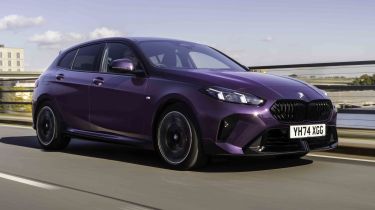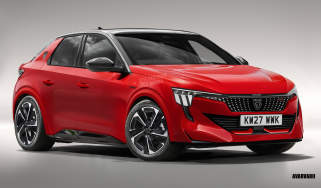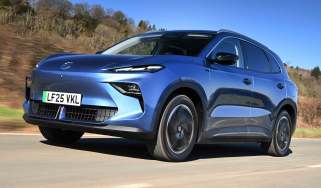BMW 1 Series - Engines, performance and drive
The 1 Series’ engine line-up looks a little slim. The three-cylinder mild-hybrid is great, but the M135 lacks excitement

Having initially launched back in 2004 as a rear-wheel-drive hatchback, and retained this layout until 2019 with the arrival of the current generation, the BMW 1 Series gained something of a reputation for fun driving dynamics. While the experience changed from behind the wheel with the introduction of the current front-wheel-drive version, the engineers at BMW have shown it’s still possible to make a hatchback that’s good to drive.
The current car is offered with two engines – a 1.5-litre turbocharged three-cylinder with mild-hybrid technology and a 2.0-litre turbocharged four-cylinder. We’d like a little more choice, and the lack of a diesel for those who regularly travel long distances is a disappointment, albeit understandable given falling sales.
The overall balance of the 1 Series remains excellent, with the lower-powered 120 feeling as agile as any of its rivals. The hot M135 delivers thrills, but perhaps not to the same extent as an Audi S3.
Refinement is a strong suit of the 1 Series – no matter the wheel size or engine, there’s an everyday usability thanks to the compliant chassis set-up and relaxing interior.
| Model | Power | 0-62mph | Top speed |
| BMW 120 | 168bhp | 7.8 seconds | 140mph |
| BMW M135 xDrive | 294bhp | 6.2 seconds | 155mph |
What is the BMW 1 Series like to drive?
In town
Despite the 1 Series’ position as one of the sportier hatchbacks in its segment, BMW hasn’t gone overboard in making it too hard-edged on the road. Yes, there’s heavy steering, but it’s simple to pootle around town thanks to decent visibility and a responsive front end, plus a sensible suspension set-up that can put up with the worst speed bumps and potholes at low speeds.
Used - available now

2021 BMW
1 Series
24,292 milesAutomaticDiesel1.5L
Cash £19,600
2019 BMW
1 Series
51,308 milesManualPetrol1.5L
Cash £10,887
2019 BMW
1 Series
30,777 milesAutomaticPetrol2.0L
Cash £16,600
2019 BMW
1 Series
56,191 milesAutomaticPetrol3.0L
Cash £18,800A turning circle of 11.7 metres isn’t amazing, and we found making quick manoeuvres with the automatic-only 1 Series isn’t as easy as before, because it takes longer to go from drive to reverse compared with manual versions of the older model. The 1 Series is not a huge car, though – it’s narrower and shorter in length than a Mercedes A-Class, so navigating tight city streets isn’t a chore.
Whether you’re sitting in the standard seats or the sportier ones in the M135, the driving position is a little high in the 1 Series, which makes it a little bit easier to drive around town in terms of visibility. The two engines are equally adept at low speeds, thanks to the smooth-shifting seven-speed automatic gearbox. In ‘Comfort’ mode, it never seems to be in the wrong gear when cruising around.
On A- and B-roads
The 1 Series utilises the UKL2 platform that underpins the BMW 2 Series Active Tourer, the BMW X1 and the MINI Countryman. In the 1 Series, it delivers a slightly harsher driving feel, but it’s not what you would call uncomfortable. In the 120 M Sport, there’s a real tautness to the chassis, helped by the Adaptive M Suspension (standard on M Sport models). This adds quicker steering, frequency-selective dampers – which are designed to learn your driving style – a lower ride height by 8mm, 50 per cent stiffer suspension bushings in the rear axle, and extra bracing.
All this creates a nimble hatchback that’s as good to drive as any in the sector. On a winding road, you can build up a rapport with the 1 Series, although with a 1,500kg kerbweight, you have to be a little steadier with steering inputs than you’d expect. The brakes on the standard car are decent enough, although the M135 test car we drove had the uprated brake option, which features the same four-piston calipers and brake pads from the BMW M3, along with larger brake discs.
They’re surprisingly usable, with a relaxed pedal feel around town, but they deliver confidence-inspiring stopping power during sprightly driving. The M135 also receives unique damping, with stiffer suspension components and further bracing underneath.
On the motorway
The 1 Series excels on a backroad thanks to a decent amount of feedback, but once you’re on the motorway it doesn’t feel jittery or tiresome – it settles down and cruises at speed well.
Much of this is helped by the heavy steering, although the cabin does a good job of isolating wind and road noise, even on the largest wheels. We find the 1 Series seats to be ideal, providing enough support when you’re slinging the car into bends, but not feeling overly stiff on a long journey. Rear passengers might not feel the same because the back seats have a rather flat bench-like layout.
Engines, 0-60 acceleration and top speed
The engine line-up for the 1 Series has become a little slim. The current generation car used to have 118i and 120i petrol options alongside the 128ti and M135i hot hatches, plus 116d, 118d and 120d diesel versions. The updated car launches with just a 120, featuring a turbocharged three-cylinder 1.5-litre accompanied by a new mild-hybrid system, and a M135 with a turbocharged 2.0-litre four-cylinder. The new 1 Series is offered in non-hybrid 116 petrol guise, 123 xDrive petrol and with 118d and 120d diesels in other markets.
However, the 120 is a good engine, and despite being a three-pot, buyers won’t feel short-changed by it. It’s flexible enough, with 168bhp and a meaty 280Nm of torque available across a large portion of the rev range. And thanks in part to the smooth integration of a 48V mild-hybrid system, throttle response is snappy enough, too. The 120 completes the 0-62mph sprint in 7.8 seconds, before topping out at 140mph.
The M135 is the 1 Series hot hatch fans will warm to, although power is down on the old car with 296bhp – instead of 302bhp – from its turbocharged four-cylinder engine. This results in a 4.9-second 0-62mph time (0.1 seconds slower than before). However, the 155mph top speed remains. It’s an excellent engine with a lovely, linear power delivery, rarely upsetting the M135’s all-wheel-drive ‘xDrive’ system. We’d like a little more bias of power to the rear, and stiffer engine mounts would certainly help it feel more involved upon acceleration. The synthesised engine sound piped through the speakers isn’t particularly immersive.









